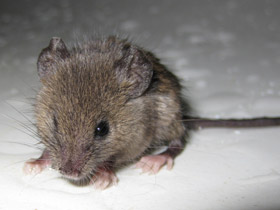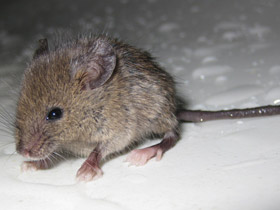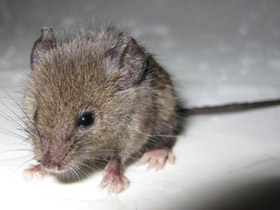The house mouse (Mus musculus)
The house mouse (Mus musculus) is a small mammal of the order Rodentia, characteristically having a pointed snout, large rounded ears, and a long and almost hairless tail. It is one of the most abundant species of the genus Mus. Although a wild animal, the house mouse has benefited significantly from associating with human habitation to the point that truly wild populations are significantly less common than the semi-tame populations near human activity.
The house mouse has been domesticated as the pet or fancy mouse, and as the laboratory mouse, which is one of the most important model organisms in biology and medicine. The complete mouse reference genome was sequenced in 2002.
Characteristics
House mice have an adult body length (nose to base of tail) of 7.5–10 centimetres (3–4 in) and a tail length of 5–10 cm (2–4 in). The weight is typically 40–45 g (1+3⁄8–1+5⁄8 oz). In the wild they vary in color from grey and light brown to black (individual hairs are actually agouti coloured), but domesticated fancy mice and laboratory mice are produced in many colors ranging from white to champagne to black. They have short hair and some, but not all, sub-species have a light belly. The ears and tail have little hair. The hind feet are short compared to Apodemus mice, only 15–19 mm (9⁄16–3⁄4 in) long; the normal gait is a run with a stride of about 4.5 cm (1+3⁄4 in), though they can jump vertically up to 45 cm (18 in). The voice is a high-pitched squeak. House mice thrive under a variety of conditions; they are found in and around homes and commercial structures, as well as in open fields and agricultural lands.
Habitat, lifestyle and habits
Mus musculus - thanks to its ecological plasticity, it has perfectly adapted to coexistence with humans, has spread throughout the world and is one of the most numerous species of mammals. It inhabits a wide variety of landscapes and habitats, including anthropogenic landscapes. These agile and skittish animals run well (at speeds of up to 12-13 km/h), climb, jump and swim well. In nature, the house mouse feeds on seeds of various wild and cultivated plants, also eats insects and their larvae, carrion. Settling in houses and outbuildings, mice are satisfied with almost any available food, up to soap, candles, glue, etc. They feed equally readily on grain, meat or dairy products. The house mouse is very prolific, in a year it can have 5-10 (and up to 14!) litters, 3-12 cubs in each. Pregnancy lasts 19-21 days. Mice are born blind and naked, but by the 10th day of life they are covered with fur, by the 21st day they become fully independent, and reach sexual maturity by the 5th-7th week of life.
Life expectancy
House mice usually live less than one year in the wild, due to a high level of predation and exposure to harsh environments. In protected environments, however, they often live two to three years.


















































